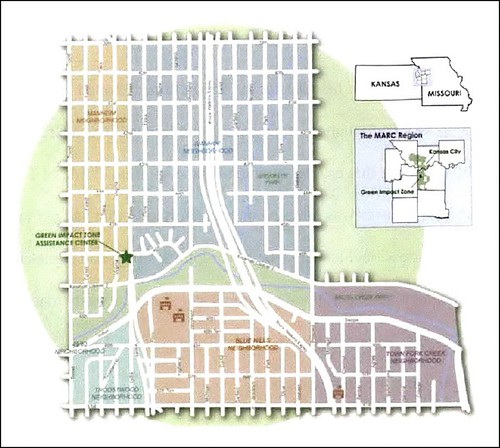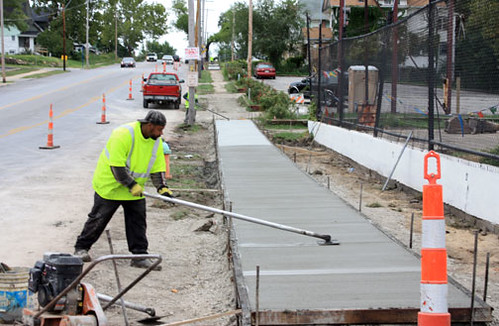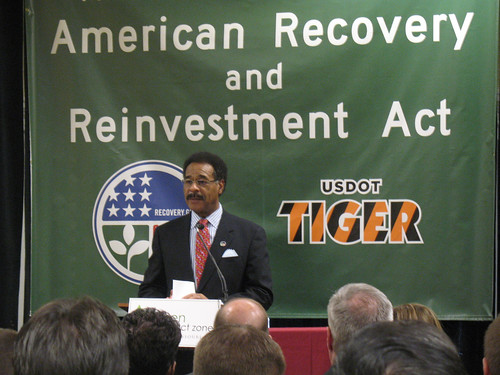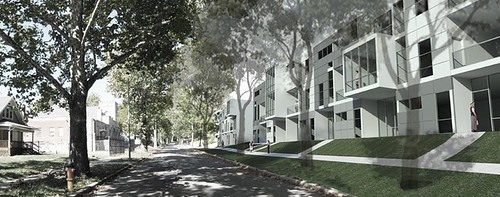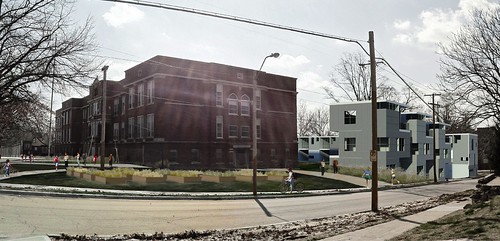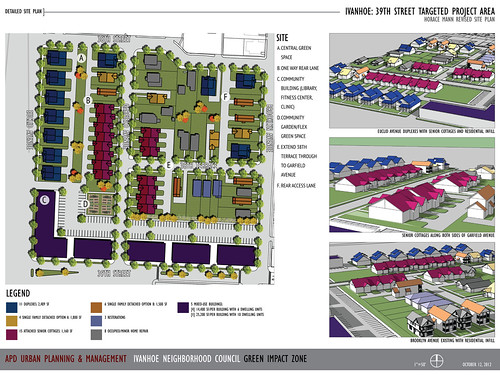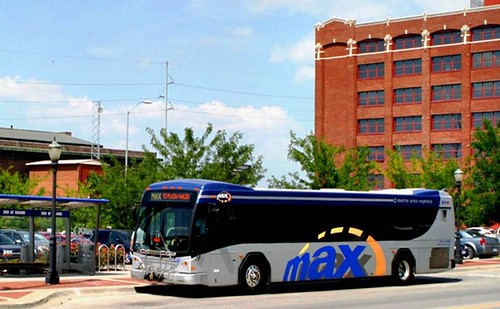Can the good work of Kansas City's Green Impact Zone be sustained?

Posted December 27, 2012 at 1:27PM
Three years ago, Kansas City’s metropolitan planning organization, the Mid America Regional Council, designated a disinvested urban district of some 150 blocks as a “Green Impact Zone.” The idea was to align potential funding from several government sources, including federal stimulus legislation, in such a way as to create jobs, spawn green business, and establish a foundation for a brighter future in the district’s neighborhoods. The initiative, which was conceived and championed by Congressman Emanuel Cleaver and quickly endorsed by other community leaders, has begun to make a difference. But, today, the money is running out and the project’s continuation is in doubt.
I first wrote about the Green Impact Zone as it was just getting started. Among the objectives initially contemplated for the district (some of which had plans that predated the designation) were these:
- “Weatherization” of homes to save energy costs (and emissions)
- Repair and construction of sidewalk, street and bridge infrastructure
- A bus rapid transit line serving the district
- A “smart grid” project to further enhance energy efficiency
- Rehab and/or demolition of vacant properties
- Job training and placement
It was also hoped that the Zone would stimulate private investment.
When the Zone was conceived, reportedly fewer than half its homes were owner-occupied and 20 percent of its mortgages were delinquent. The median home price was $30,000, and statistics suggested unemployment could be as high as 50 percent. About a third of the population lived below the poverty level, and median household and per capita income were only slightly more than half that of Kansas City as a whole. The area suffered from a history of crime.
Indeed, in a thoroughly researched and documented 2010 master’s thesis at MIT, Leila Bozorg makes a compelling case that the district, 90 percent African-American, is “an area of the city that was historically the target of formal, racist policies that were meant to physically and socially marginalize the populations therein.” (Bozorg's paper is an excellent discussion of the conceptual underpinnings of the innovative project.)
Viewed from the perspective of today, there is no doubt that the Green Zone has, in fact, had a beneficial impact on the five neighborhoods in the district. A “summary of key results in three priority focus areas over the past three years” attached to the Zone’s most recent progress report lists an impressive array of accomplishments, all of which begin to lay a foundation for the Zone’s revitalization.
In particular, many of the district’s curbs and sidewalks have been repaired or rebuilt, some with pervious pavement to absorb stormwater, thanks to a $26 million “TIGER” grant from the federal Department of Transportation. A significantly enhanced bus line (if not quite true BRT with a fully dedicated lane) was established. With the assistance of Department of Energy funds, workers weatherized (I hate that word, but I can’t think of a better one) and retrofitted older buildings for energy efficiency.
Kansas City Power & Light stepped up in a big way, installing 2600 in-home “smart meters” to assist residents in monitoring and managing daily electricity usage and associated expenses. The utility also worked with neighborhood youth to install solar panels on a local high school. In addition, KCP&L established a “SmartGrid Innovation Park” in the district that opened in October, as an educational complement to the work on efficiency infrastructure. From the Green Impact Zone’s blog:
“The SmartGrid Innovation Park contains a walking path and sitting plaza that surround a large, sophisticated lithium ion battery and a solar panel array — both of which help the grid meet the energy needs of people who live and work within the SmartGrid Demonstration Area. It also houses an electric vehicle charging station and an information kiosk. The park is open seven days a week and admission is free.”
The investment in infrastructure has supported significant new attention to revitalization in the district. Fifty new affordable, green (LEED platinum) rental homes are being constructed in the Manheim Park neighborhood on the site of the former Bancroft School, which (sadly) has been vacant since 1999. The project, which includes rehabbed units in the historic school building, is being developed by a consortium of partners including the Make It Right Foundation; it will feature a number of community amenities including an auditorium, a gymnasium and locker rooms, a technology lab, a job-training center, a mobile medical clinic and community gardens. A solar-power array is being built on the school’s roof.
(I’m not a huge fan of the architectural design either here or in at least one other Make It Right project, because it tends to overlook opportunities to blend more seamlessly into traditional neighborhoods. But the green housing goals are laudable.)
In the Southeast Ivanhoe neighborhood, the neighborhood association is beginning to implement a long-in-the-works master plan for housing along a key corridor. The Ivanhoe plan includes new single-family and detached homes, new senior cottages, restoration and repair of older homes, and several mixed-use buildings. In another part of the district, the new Blue Hills Community Service Center will include a training and business Incubator for the construction trades.
Throughout the district’s five neighborhoods, the Green Zone staff successfully worked to bring the Google fiber-optic broadband network to the community. Police presence in the neighborhood has been strengthened and crime is down. Neighborhood organizations have been strengthened with targeted investments in legal support, equipment, special events and capacity building.
It should be noted that implementation of the Zone’s ambitious initiatives, though hugely successful in some ways, has not been perfect. A story written by Mike Hendricks and published in The Kansas City Star earlier this month suggests that the weatherization program was never fully implemented because of problems with its administration. The initiative created a few hundred new jobs, not the one thousand that was hoped for.
But the real point is the progress that has been made. Any neighborhood revitalization takes years, even decades, to be fully realized, and many of these initiatives and others are currently in progress. Yet funding for the Green Zone’s administrative structure, including a seven-person staff established by the Regional Council, has been on a three-year timeline and is about to expire. According to Hendricks’s article, local tax dollars will no longer go to pay the salaries and expenses of the Green Impact Zone staff after the current budget year ends on April 30. Then what?
Kansas City Councilwoman Cindy Circo told Hendricks she gives the project an “A” grade for creating positive momentum, including extensive community engagement that “has really changed the philosophy of the neighborhood” in a much more positive direction. But, although she has been a strong supporter of the Zone, she adds that “In my mind, there needs to come a day when the focus switches elsewhere.”
In a way, that’s hard to argue. There is no more federal stimulus money. And the very concept of the Green Impact Zone in Kansas City was an effort to channel to one particular needy area federal funds that might otherwise be spread around. Hendricks writes that combined public and private investment in the Zone over three years amounted to $178 million. Fairness would seem to weigh in favor of other areas and other initiatives at some point.
But it still seems a shame to walk away from unfinished business, even if that’s what the budget demands. Community leaders are exploring possibilities for new sources of private funding to fill the gap.
Watch the video below to get a sense of the initiative through the eyes of local residents and officials:
Related posts:
- Kansas City’s Green Impact Zone: making great use of stimulus funds (September 28, 2009)
- HUD builds impressive record of support for smarter community planning (December 5, 2012)
- National arts partnership steps up big for community revitalization (June 12, 2012)
- The right approach to green, inclusive revitalization (May 10, 2012)
- A remarkable grassroots revitalization matures and thrives in Boston (March 26, 2012)
- HUD launches Sustainable Communities Resource Center (February 16, 2012)
- Urban revitalization is green. Let's make it greener, greater, and more inclusive. (August 10, 2011)
- Creative resourcefulness: Kansas City's "Container Home" (March 12, 2009)
Move your cursor over the images for credit information.

